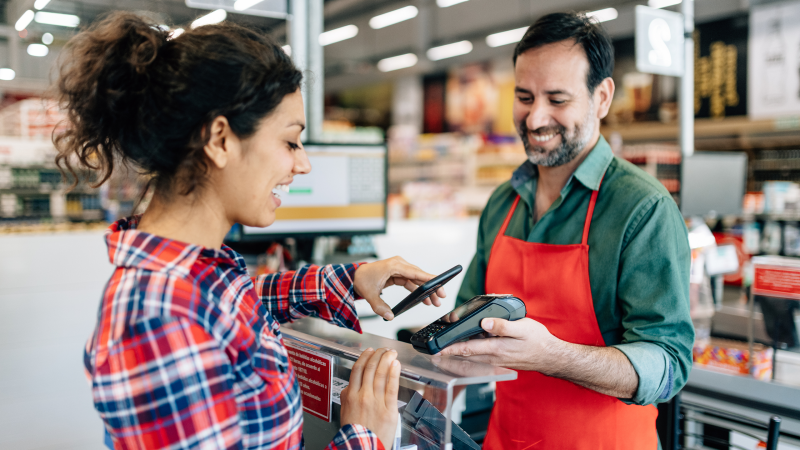How do I use my digital wallet?

How do I use my digital wallet, and what exactly is it? Put simply, a digital wallet is an electronic alternative to your physical wallet for storing card data and other financial information. A digital wallet may offer some benefits, particularly in terms of convenience and security. Let’s look at how to use your digital wallet and a few tips for picking the right digital wallet for you.
How to use a digital wallet
A digital wallet is a software-based platform that securely stores payment information, such as your debit and credit card details. This platform helps you make transactions without the physical card present. In essence, a digital wallet is a “digitized” version of your traditional wallet, collecting your payment information in a single place. Here’s how to use a digital wallet, step-by-step, so you can decide if a digital wallet is right for you.
Download and install the app
When researching digital wallets, prioritizing those with up-to-date security measures may help reduce your exposure to fraud. You’ll find tips below on how to choose a digital wallet suited to your needs. If you already have a digital wallet in mind, and it’s an app that wasn’t included on your device, you can typically download the app on your smartphone, tablet or computer. Be sure to download the app from an official source to help ensure it’s a genuine version. Some banks make it easy for you to add your card to a digital wallet right from their app.
Create an account
After installing the wallet, you’ll usually be prompted to create an account or sign into an existing one. During the account creation process, you may also be asked to provide personal information, such as your name, email address and phone number.
Secure your digital wallet
Next, you should create a strong, unique password or PIN to protect your digital wallet. Depending on the wallet, you might also have the option to enable biometric authentication, such as fingerprint or facial recognition.
Add payment information
Before making payments with your digital wallet, you’ll typically have a chance to add your preferred payment methods. Digital wallets often accommodate a variety of payment cards, including debit cards, credit cards, loyalty cards and gift cards. The input process usually involves either keying in your card or account details manually or scanning the card using your device’s camera.
Start making payments
With everything set up, you can start making payments using your digital wallet. Look for compatible payment terminals at the point of sale, then tap or scan your device to initiate each transaction. Some online payment gateways may also provide options to pay with your digital wallet online.
Benefits of digital wallets
Digital wallets may offer several benefits to customers but may also pose a potential downside. Let’s explore some considerations:
- Convenience: The capacity of a digital wallet is unlimited by physical space, allowing you to carry numerous payment methods in a single platform. If you have many cards, this may free up your physical wallet to help keep you more organized.
- Security: Many popular digital wallets employ high-level encryption that may help improve security and possibly reduce the likelihood of unauthorized access. Digital wallets do not store a customer’s actual credit or debit card number and instead generate a code, or token, that is sent, and may be a safer way to pay and help protect your card number.
- Faster transactions: Because many payment terminals accept contactless payments, digital wallets on smart devices might increase transaction speed by letting you “tap” to complete a purchase.
- Loyalty program integrations: Some digital wallets allow you to store loyalty cards and rewards programs to help you track points and redeem rewards without the worry of several apps or different cards.
One potential downside to using a digital wallet may be that you would be dependent on your device for payment. Because your digital wallet is a software-based platform, if you lose your device or the battery runs low, you may lose wallet access.
How to choose a digital wallet
There are numerous digital wallets available nowadays. Now that we’ve learned how to use a digital wallet, let’s explore a few considerations to help narrow down your choices for digital wallets that may work for you.
Device compatibility
Thinking ahead about devices you use may help prevent compatibility issues down the road. Some digital wallets are “locked in” on singular platforms or devices, while others offer more cross-platform capability.
Fees and charges
Some digital wallets are free whereas others may charge fees. Taking time to compare charges between different digital wallets might help avoid unexpected costs.
Rewards programs
If you participate in loyalty programs, looking for a digital wallet that allows you to integrate these may make it easier to preserve your points and redeem rewards.
In summary
If you’re still wondering, “How do I use my digital wallet?”, remember that most digital wallets work by downloading them onto a smart device through a mobile app and then providing your payment information. A digital wallet stores a “digitized” version of your card data, creating an electronic version of your physical wallet. Digital wallets may help make payments faster and more convenient.



